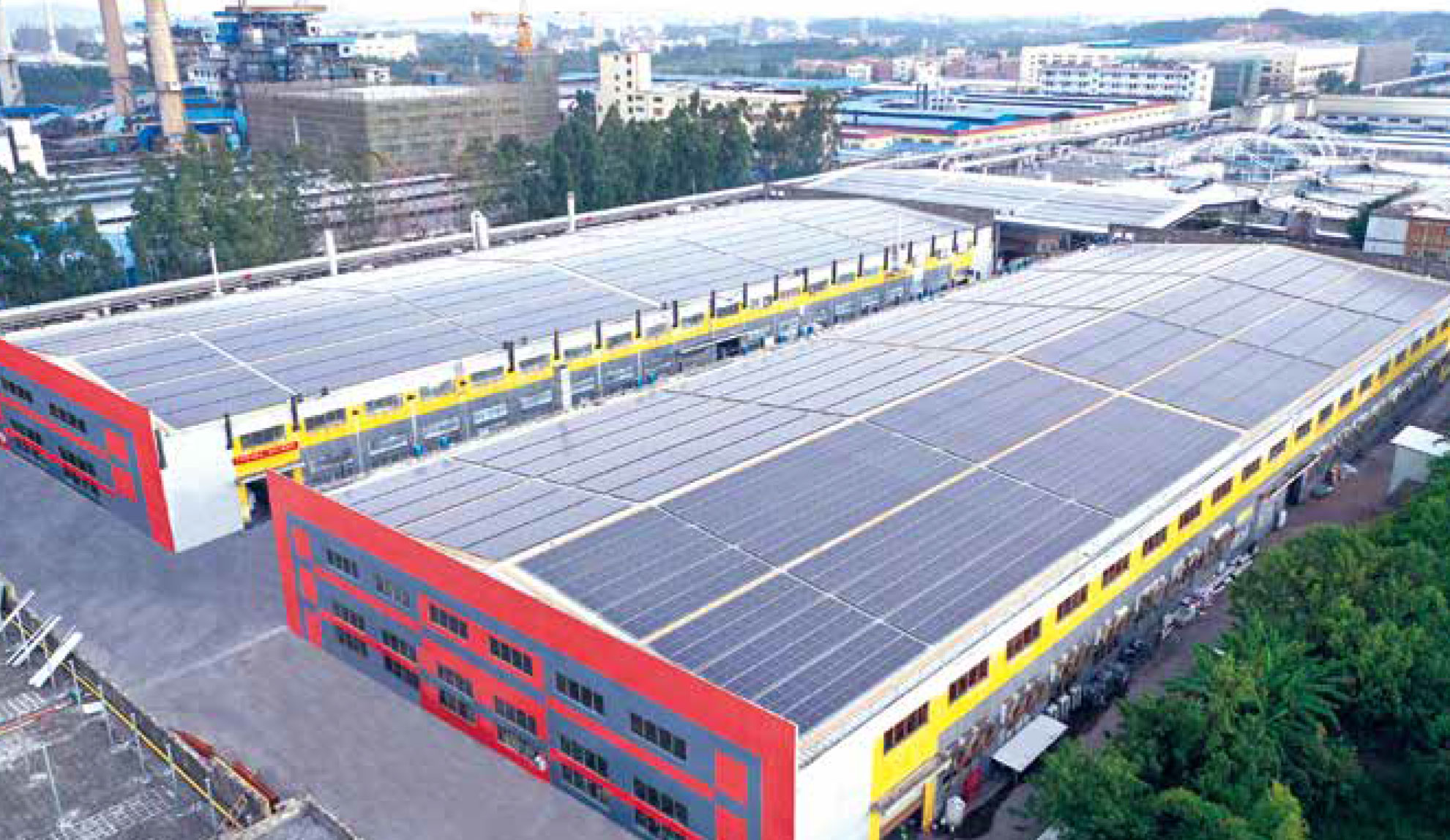分布式光伏通常在建筑物屋顶,工厂屋顶和蔬菜棚之类的地方建造,以充分利用空间。那么,
分布式光伏发电和集中式光伏之间的异同是什么呢?
Distributed photovoltaic is usually built on the roofs of buildings, factories and vegetable sheds to make full use of space. So, what are the similarities and differences between distributed photovoltaic power generation and centralized photovoltaic power generation?
相同之处:
Similarities:
1)原理相同,都是利用太阳能将其转换为电能,然后将产生的电能连接到并网发送到电网进行生产和生活使用。
1) The principle is the same. They use solar energy to convert it into electric energy, and then connect the generated electric energy to the grid and send it to the grid for production and domestic use.
2)组件相同,通常使用单晶硅电池板或太阳能薄膜。
2) The components are the same, usually using monocrystalline silicon panel or solar film.
3)所使用的主要设备基本一致,包括逆变器,变压器,汇流箱等设备。逆变器的功能是将产生的直流电转换为交流电。变压器的功能是增强逆变器转换的交流电。汇流箱的功能是收集太阳能电池板的直流电,然后将它们汇聚一处,融合以统一输送至逆变器上。
3) The main equipment used is basically the same, including inverter, transformer, combiner box and other equipment. The function of the inverter is to convert the generated DC power into AC power. The function of the transformer is to enhance the AC power converted by the inverter. The function of the combiner box is to collect the DC power of the solar panels, and then gather them together for unified transmission to the inverter.
不同之处:
Differences:
1)安装位置不同:分布式光伏发电主要安装在屋顶上,主要分布在人们居住的华北和华南地区。集中式光伏则主要安装在戈壁和沙漠中。通常,它们安装的区域相对偏远且荒凉,土地相对便宜。西北地区主要是宁夏,甘肃,新疆,青海等地区。
1) Different installation locations: distributed photovoltaic power generation is mainly installed on the roof, mainly distributed in North China and South China where people live. Centralized PV is mainly installed in Gobi and desert. Generally, the area where they are installed is relatively remote and desolate, and the land is relatively cheap. The northwest region is mainly Ningxia, Gansu, Xinjiang, Qinghai and other regions.

2)不同的并网电压等级:对于分布式光伏,通常将380V电压连接到电网,并且通常使用低压脱扣器并网,并且分布式并网点的数量取决于实际情况。 集中式光伏电站的并网电压通常为35KV或110KV。如果电站的功率小于或等于30兆瓦,通常不会有主变压器,并且这种超过35KV的电网会连接到电网。对于30 MW以上的电站,通常会安装主变压器,并将主变压器升级到110KV电压等级后并网。
2) Different grid connection voltage levels: for distributed PV, 380V voltage is usually connected to the grid, and low-voltage release is usually used for grid connection, and the number of distributed grid connection points depends on the actual situation. The grid-connected voltage of centralized photovoltaic power stations is usually 35KV or 110KV. If the power of the power station is less than or equal to 30 MW, there is usually no main transformer, and this kind of power grid exceeding 35 KV will be connected to the power grid. For power stations above 30 MW, the main transformer is usually installed and connected to the grid after the main transformer is upgraded to 110 KV voltage level.
3)电站中使用的二次设备有所不同:由于分布式光伏电站是低压380V并网设备,因此较少用于一次设备和二次设备。其中,逆变器通常是壁挂式逆变器,其安装相对简单并且尺寸小。变压器也是那种小型变压器。常用的微机保护包括电能质量监控,防孤岛保护装置和故障解列。
3) The secondary equipment used in the power station is different: since distributed photovoltaic power stations are low-voltage 380V grid-connected equipment, they are less used for primary and secondary equipment. Among them, the inverter is usually wall-mounted inverter, which is relatively simple to install and small in size. Transformer is also a kind of small transformer. Commonly used microcomputer protection includes power quality monitoring, anti-islanding protection device and fault splitting.
根据地区要求,设备要求和技术参数要求也有所不同。但是目前,防孤岛保护装置是每个分布式光伏必须使用的装置。集中式光伏电站通常由于其相对较高的电压水平而具有自己的变电站。逆变器通常位于变电站室内,并且具有较大的尺寸。升压功能通过更换箱体完成,通常高35KV。升压站中有很多设备。
According to regional requirements, equipment requirements and technical parameters are also different. However, at present, the anti-islanding protection device is a necessary device for each distributed photovoltaic system. Centralized photovoltaic power stations usually have their own substations due to their relatively high voltage levels. The inverter is usually located in the substation room and has a large size. The boosting function is completed by replacing the box, usually 35KV high. There are many equipment in the booster station.
主要设备包括电站变压器,开关柜,各种变压器,消弧线圈和主变压器。二次设备包括微机保护装置,电度表,调度数据屏等。比较复杂的调度直接实现了电站的集中管理。同时,该站还需要一个功率预测系统和一个功率控制系统,这比分布式光伏系统要复杂不少。
Main equipment includes power station transformer, switch cabinet, various transformers, arc suppression coil and main transformer. Secondary equipment includes microcomputer protection device, watt-hour meter, dispatching data screen, etc. The complex dispatching directly realizes the centralized management of the power station. At the same time, the station also needs a power prediction system and a power control system, which is much more complex than the distributed photovoltaic system.
4)不同的传输距离:分布式光伏发电一般是指发的电就地并网的,线损非常低或可以说没有。补充当地电力,以供当地和附近的用电者使用。集中式光伏发电站产生的电力通过高压并网,将电力逐层输送到更高的电压等级,再将高压电力传输到东部地区,实现电力西电东输。
4) Different transmission distances: distributed photovoltaic power generation generally refers to the local grid connection of generated electricity, with very low or no line loss. Supplement local power for local and nearby consumers. The power generated by the centralized photovoltaic power station is connected to the grid through high voltage, and the power is transmitted to a higher voltage level layer by layer, and then the high voltage power is transmitted to the eastern region to realize the power transmission from the west to the east.
总之,分布式光伏和集中式光伏之间存在许多相似之处与不同之处。分布式光伏的前景更好,相同规模的发电厂的投资额也差不多。而且,分布式光伏装置的处在人员较多的地方,维护也更加方便。更多相关内容就来我们网站
http://www.zdnygf.com咨询吧!
In short, there are many similarities and differences between distributed PV and centralized PV. The prospect of distributed photovoltaic is better, and the investment amount of power plants of the same scale is similar. In addition, distributed photovoltaic devices are located in places with more people, and maintenance is more convenient. Come to our website for more relevant content http://www.zdnygf.com Ask!



 TEL:0531-82390078
TEL:0531-82390078 TEL:18805312017
TEL:18805312017 MAI:sdzdny001@163.com
MAI:sdzdny001@163.com 公司地址: 济南市历下区山大路157号
公司地址: 济南市历下区山大路157号 天合蓝天·山东种电
天合蓝天·山东种电 备案号:鲁ICP备17052940号-2
鲁公网安备37010202700164号
备案号:鲁ICP备17052940号-2
鲁公网安备37010202700164号
 网站地图|XML|TXT
网站地图|XML|TXT

